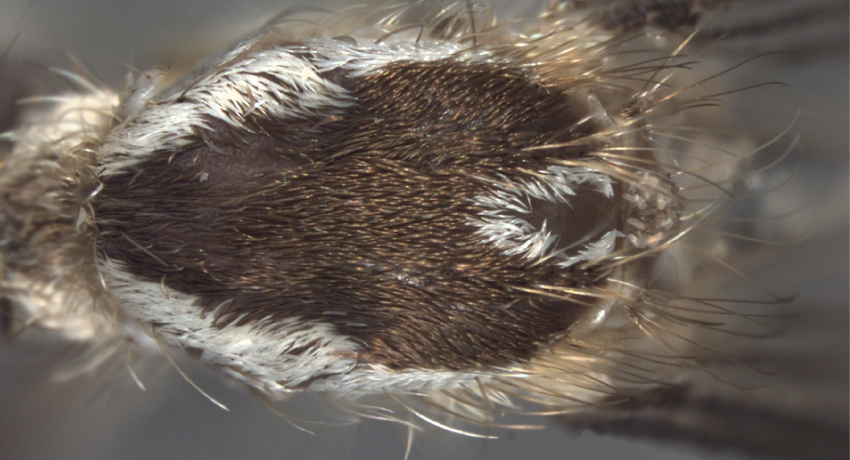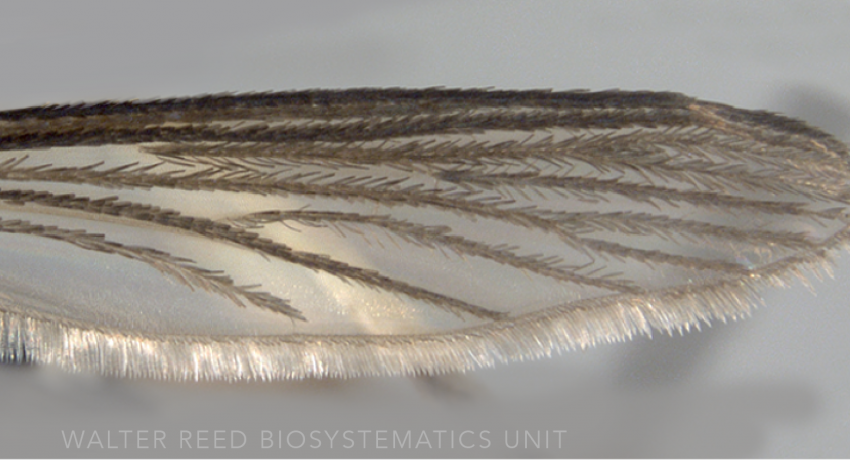NEARCTIC REGION
Etymology: not stated [three serrations (L); probably refers to three white spots on abdominal segments]
Aedes triseriatus is associated with hardwood forests across its range. It is a striking mosquito, with dark legs, contrasting silvery white markings across its body segments, and three white spots on its abdominal segments, for which it was named. Aedes triseriatus was intercepted in France in 2004 in a batch of used tires imported from Louisiana, United States. It was eradicated before the species could become established.
Type locality: Pennsylvania, United States
Type depository: Type non-existent (NE)
DIAGNOSTIC CHARACTERS (Click photos to view; mouse over and click large photo to zoom in.)
ADULT (illustrated): Head: Proboscis and palpus dark-scaled; clypeus without scales; vertex with numerous erect and narrow curved scales. Thorax: Scutum with lateral silvery white stripes; prescutellar area dark, bordered by a line of slender white scales; pleuron with silvery-white scale patches on paratergite, mesepimeron and postpronotum; C-III lateral surface with scales. Abdomen: Sternum with basal silvery-white bands; tergum with basolateral silvery-white scale patches. Wing: Base of costa usually dark-scaled. Legs: All tarsi entirely dark-scaled.
LARVA (not illustrated): Head: Seta 1-C thickened, distinct. Abdominal segments: Seta 12-I present. Terminal segments: Comb scales fringed, 10–13, in irregular rows; seta 4-X with 4 pairs of setae, and 2 pairs of precratal setae.
TAXONOMIC KEYS
Carpenter & LaCasse 1955
Ross & Horsfall 1965
Dodge 1966
Darsie & Ward 2005
Harrison et al. 2016
Exemplar DNA sequences
Ae. triseriatus COI: AF417730, MG242523, JX259685–88, JX260473
BIONOMICS
Immatures
Female Ae. triseriatus typically oviposit in hardwood tree holes, up to 27m high into the canopy, but are also known to occupy shaded artificial containers in forest environs, including discarded tires, and vary rarely pools, ponds, streams and marshes. Aedes triseriatus is essentially isomorphic with Ae. hendersoni Cockerell in all life stages except the 4th instar larva, leading to conflicting reports of bionomic traits. Aedes triseriatus is univoltine and eggs undergo staggered egg ecolsion. Larva are found from March to October,with several population peaks from early July until late August, when the population starts to decline. Aedes triseriatus overwinters as eggs in northern populations, where neonates hatch following the thaw of tree hole waters. In temperate regions, where the tree holes do not freeze, the species passes the winter as larvae.
Adults
Female Ae. triseriatus rest in heavily shaded areas close to the larval habitats, but will fly into open areas to feed. They feed opportunistically on a wide range of woodland mammals including deer, squirrels, opossums, rats, rabbits, and chipmunks. Where other mammals are rare, Ae. triseriatus feed on people in the forest, as well as birds, amphibians and reptiles. The species is an important vector of La Crosse virus (LACV) in the United States, for which Ae. triseriatus can transmit trans-ovarially by females and sexually by the males. Significantly, females infected with LACV in the laboratory took smaller blood meals, re-feeding several times during one egg development cycle.
DISTRIBUTION NOTES
Canada, Cuba, Greenland, Mexico, United States (continental).

WRBU VECTOR HAZARD REPORTS
None; View other WRBU Vector Hazard Reports
Available GIS Models
Ae_triseriatus_Dornak_1 North America
IMPORTANT REFERENCES (full citations below)
Say 1823: 12 (F; as Culex)
Mitchell 1907 (E*)
Howard et al. 1913 (1912) (E*)
Howard et al. 1917 (E)
Ross 1947: 65 (M*, F*, L*)
Darsie 1951: 14 (P*)
Yamaguti & LaCasse 1951d: 234 (M*, F*, L*)
Rempel 1953: 483 (M*, F*)
Carpenter & LaCasse 1955: 255 (M*, F*, L*; keys)
Craig 1956 (E*)
Horsfall & Craig 1956: 370 (E*)
Price 1960: 558 (1st instar L*)
Ross & Horsfall 1965 (M*, F*, L*, E*; keys)
Dodge 1966: 358 (1st instar L*; key)
Mohrig 1967 (F*)
Kalpage & Brust 1968 (E*)
Harmston 1969: 490 (F*)
Pratt & Kidwell 1969 (E*)
Horsfall et al. 1970: 1710 (E*)
Zavortink 1972: 27 (M*, F*, P*, L*; distribution)
Grimstad et al. 1974: 795 (taxonomy)
Lunt 1977b: 654 (taxonomy)
Saul et al. 1977: 705 (molecular taxonomy)
Zaim et al. 1977: 489 (E*)
Linley 1989a (E*)
Linley & Craig 1993: 65 (E*)
Reinert 2002e: Fig. 34 (F*)
Juliano & Lounibos 2005 (bionomics, review)
Darsie & Ward 2005 (F*, L*; keys, distribution)
Sánchez-Trinidad et al. 2014 (bionomics, distribution; Mexico)
Harrison et al. 2016 (F*, L*; keys, distribution; note 13)
CURRENT SYNONYMS
syn. nigra Ludlow
1905c: 387 (F; Finlaya). Type locality: Rock Island Arsenal, Illinois, United States (USNM).
CURRENT SUBSPECIES
None
CITED REFERENCES
Carpenter, S.J., & LaCasse, W.J. (1955). Mosquitoes of North America (North of Mexico). Berkeley, Los Angeles: University of California Press.
Craig Jr., G.B. (1956). Classification of eggs of nearctic Aedinae mosquitoes (Diptera: Culicidae). Dissertation Abstract (5).
Darsie, R.F., Jr. (1951). Pupae of the culicine mosquitoes of the northeastern United States (Diptera, Culicidae, Culicini). Ithaca, NY: Cornell University Agricultural Experiment Station Memoir 304.
Darsie, R.F., Jr., & Ward, R.A. (2005). Identification and geographical distribution of the mosquitoes of North America, north of Mexico. Gainesville, FL: University Press of Florida.
Dodge, H. R. (1966). Studies on mosquito larvae II. The first-stage larvae of North American Culicidae and of world Anophelinae. Canadian Entomologist, 98, 337–393.
Grimstad, P.R., Garry, C.E., & Defoliart, G.R. (1974). Aedes hendersoni and Aedes triseriatus (Diptera: Culicidae) in Wisconsin: Characterization of larvae, larval hybrids, and comparison of adult and hybrid mesoscutal patterns. Annals of the Entomological Society of America, 67(5), 795–804.
Harmston, F.C. (1969). Separation of the females of Aedes hendersoni Cockerell and Aedes triseriatus (Say) Diptera: Culicidae by the tarsal claws. Mosquito News, 29, 490–491.
Harrison, B.A., Byrd, B.D., Sither, C.B., & Whitt, P.B. (2016). The mosquitoes of the Mid-Atlantic Region: an identification guide (Vol. 1). Madison Heights, MI: Publishing XPress.
Horsfall, W.R., & Craig, G.B. Jr. (1956). Eggs of floodwater mosquitoes IV. Species of Aedes common in Illinois. (Diptera: Culicidae). Annals of the Entomological Society of America, 49(4), 368–374.
Horsfall, W.R., Voorhees, F.R., & Cupp, E.W. (1970). Eggs of floodwater mosquitoes. XIII. Chorionic sculpturing. Annals of the Entomological Society of America, 63, 1709–1716.
Howard, L.O., Dyar, H.G., & Knab, F. (1913). The mosquitoes of North and Central America and the West Indies. (Vol. II) (1912). Washington, D.C.: Carnegie Institution of Washington.
Howard, L.O., Dyar, H.G., & Knab, F. (1917). The mosquitoes of North and Central America and the West Indies. Systematic description. Part II. Carnegie Institute of Washington.
Juliano, S.A., & Lounibos, L.P. (2005). Ecology of invasive mosquitoes: Effects on resident species and on human health. Ecology Letters, 8(5), 558–574.
Kalpage, K.S., & Brust, R.A. (1968). Mosquitoes of Manitoba. 1. Descriptions and a key to Aedes eggs (Diptera: Culicidae). Canadian Journal of Zoology, 699–718.
Linley, D.J. (1989a). Scanning electron microscopy of the egg of Aedes (Protomacleaya) triseriatus (Diptera: Culicidae). Journal of Medical Entomology, 26(5), 474–478.
Linley, J.R., & G.B. Craig, J. (1993). The egg of Aedes hendersoni and a comparison of its structure with the egg of Aedes triseriatus (Diptera: Culicidae). Mosquito Systematics, 25(2), 65–76.
Ludlow, C.S. (1905c). Mosquito notes. IV. Canadian Entomologist, 37, 385–388.
Lunt, S.R. (1977b). Morphological characteristics of the larvae of Aedes triseriatus and Aedes hendersoni in Nebraska. Mosquito News, 37(4), 654–656.
Mitchell, E.G. (1907). The classification of the Culicidae. Canadian Entomologist, 198–201.
Mohrig, W. (1967). Die taxonomische Bedeutung der Struktur weiblicher Genitalien im Culiciden- Tribus Aedini. Angewandte Parasitologie, 8, 67–100.
Pratt, H.D. & Kidwell, A.S. (1969) Eggs of mosquitoes found in Aedes aegypti oviposition traps. Mosquito News, 29(4), 545—548.
Price, R.D. (1960). Identification of first-instar aedine mosquito larvae of Minnesota (Diptera: Culicidae). Canadian Entomologist, 92, 544–560.
Reinert, J.F. (2002e). Comparative anatomy of the female genitalia of genera and subgenera in tribe aedini (Diptera: Culicidae). Part XIII. Genus Ochlerotatus Lynch Arribalzaga. Contributions of the American Entomological Institute, 33(1), 1–111.
Rempel, J.G. (1953). The mosquitoes of Saskatchewan. Canadian Journal of Research, 31, 433–509.
Ross, H.H. (1947). The mosquitoes of Illinois (Diptera, Culicidae). Bulletin of the Illinois Natural History Survey, 24(1), 1–96.
Ross, H.H., & Horsfall, W.R. (1965). A synopsis of the mosquitoes of Illinois (Diptera, Culicidae). Illinois Natural History Survey Biological Notes, 52, 1–50.
Sanchez-Trinidad, A., Ordenez-Sanchez, F., Valdes-Pérezgasga, M. T., Sanchez-Ramos, F. J., Zavortink, T.J., Cortes-Guzmán, A. J., & Ortega-Morales, A. I. (2014). Geographical distribution of the Aedes Triseriatus Group (Diptera: Culicidae) in Mexico. Journal of Vector Ecology, 39(1), 134–137.
Saul, S.H., Sinsko, M.J., Grimstad, P.R., & Craig, G.B., Jr. (1977). Identification of sibling species, Aedes triseriatus and Ae. hendersoni, by electrophoresis. Journal of Medical Entomology (Honolulu), 13(6), 705–708, illust.
Say, T. (1823). Descriptions of dipterous insects of the United States. Journal of the Academy of Natural Sciences of Philadelphia, 3, 9–54.
Yamaguti, S., & LaCasse, W.J. (1951d). Mosquito fauna of North America. Part V – Genus Aedes. Office of the Surgeon, Headquarters, 8th Army, APO 343. United States. Office of the Surgeon-General. 207th Malaria Survey Detachment.
Zaim, M., Lewandowski, H.B., Newson, H.D., & Hooper, G.R. (1977). Differentiation of Aedes triseriatus and Ae. hendersoni (Diptera: Culicidae) based on the surface structure of the egg shell. Journal of Medical Entomology, 14(4), 489–490.
Zavortink, T.J. (1972). Mosquito studies (Diptera, Culicidae) XXVIII. The new world species formerly placed in Aedes (Finlaya). Contributions of the American Entomological Institute, 8(3), 1–206.
CITE THIS PAGE
Walter Reed Biosystematics Unit (Year). Aedes triseriatus species page. Walter Reed Biosystematics Unit Website, http://wrbu.si.edu/vectorspecies/mosquitoes/triseriatus, accessed on [date (e.g. 03 February 2020) when you last viewed the site].












































































































































































